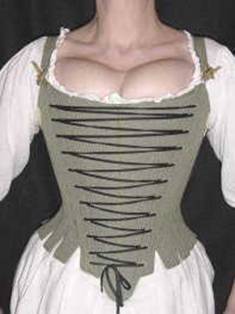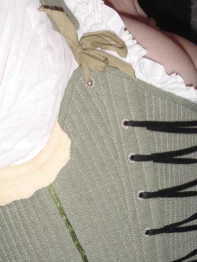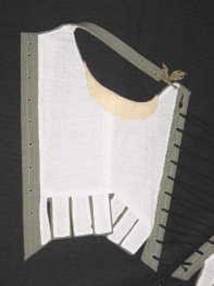
Working Class Stays 1740's - 1760's
These stays are made in a cotton/linen fabric, which in the 18th century would have been called fustian. Front lacing meant that the wearer would be able to dress herself and could alter the fit of the stays by increasing or decreasing the gap across the stomacher. Stays were normally made by men and involved a lot of skill and hard work. In the 18th century all the stitching was worked by hand since sewing machines were not available till the 1850's.
 Rows of hand stitching, using 12 to 16 stitches to 2.5 cm/ 1", were sewn through 3 or 4 layers of canvas and a top fabric. This produced a series of channels into which were slotted slips of whalebone, usually only 4 or 5 mm wide by 2 mm thick.
The hand stitching is so regular that it looks like machine stitching. Some of these stitch lines are visible in the detail of my replica to the right.
Rows of hand stitching, using 12 to 16 stitches to 2.5 cm/ 1", were sewn through 3 or 4 layers of canvas and a top fabric. This produced a series of channels into which were slotted slips of whalebone, usually only 4 or 5 mm wide by 2 mm thick.
The hand stitching is so regular that it looks like machine stitching. Some of these stitch lines are visible in the detail of my replica to the right.
Sometimes on working women's stays the underarm was bound or covered with leather to soften the edge. This became a decorative as well as practical feature and often the leather was cut with scalloped edges.
 All levels of society wore stays but the stays of the lower classes might be made more flexible or more easily fastened, particularly if the wearer had to dress herself. The cheapest stays were made of leather that was scored with a knife to give it more flexibility. In the later 18th century shoulder straps were often made of unstiffend fabric or not attached at all.
All levels of society wore stays but the stays of the lower classes might be made more flexible or more easily fastened, particularly if the wearer had to dress herself. The cheapest stays were made of leather that was scored with a knife to give it more flexibility. In the later 18th century shoulder straps were often made of unstiffend fabric or not attached at all.
Even if you worked in the fields or were so poor that you had to live in a workhouse you still would wear stays. There are records of money being given to the homeless so that they could buy stays and be decently dressed.
These replica stays are made in three sections: two half bodies and a triangular stomacher at the front. On the right can be seen the inside of one of the half bodies. Although stays like these were cut from a number of shaped panels the linings were normally cut in fewer, larger sections. Tabs or tassets were always individually lined.
